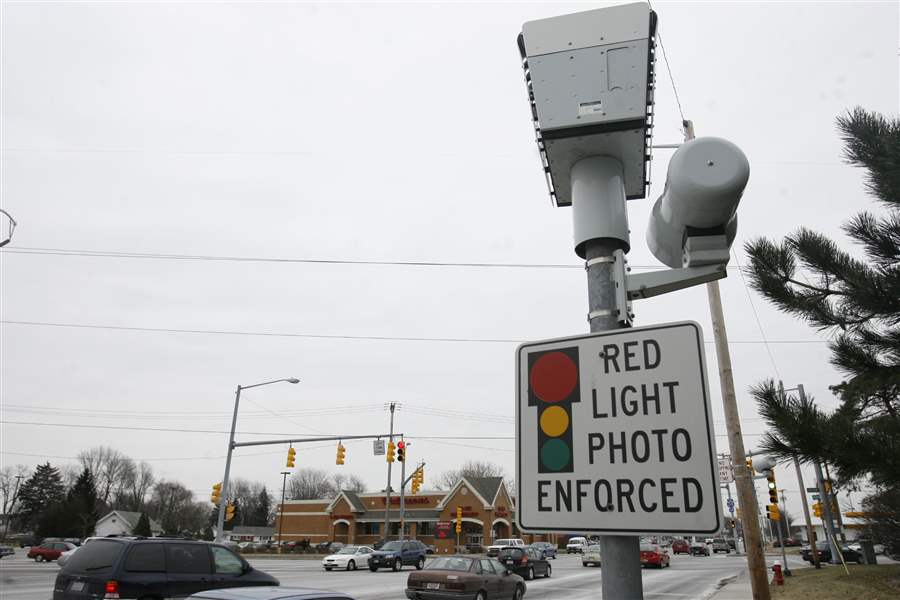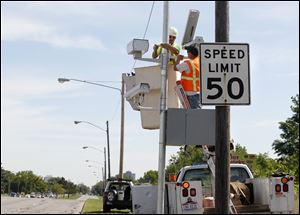
CITY OF TOLEDO
Traffic cams net nearly $3 million in 2012
Cameras have issued 68,159 citations for red-light, speed violations
2/25/2013
A camera on the southbound corner of Secor Road and Monroe Street is one of 43 scattered around the city. The devices have withstood numerous legal challenges.
The Blade
Buy This Image

A camera on the southbound corner of Secor Road and Monroe Street is one of 43 scattered around the city. The devices have withstood numerous legal challenges.
Stacey Richard was driving along Alexis Road in West Toledo last summer and got caught in what she calls one of the city’s traps.
Like thousands of motorists traversing the city, she got slapped with a citation but was never stopped by a police officer.
“I received a ticket at one of those entrapment spots and guess what, I didn’t pay it because I think it is a miscarriage of justice against my civil rights,” Ms. Richard, a nursing student, said half-jokingly. “I have no problem expressing my opinion of these speed traps.”
Ms. Richard received one of the 68,159 citations last year from red light or speed cameras.
“I got it around August at the Whitmer High School location and I researched these lights and found out that the city doesn’t even own them,” she said. “I also found out that they can’t do anything but turn you into the credit bureau, so I didn’t pay it. I think it’s entrapment for sure.”
That intersection alone, at Alexis Road and Whitmer Drive, was one of the most expensive for area drivers — capturing 12,451 speeding vehicles and 201 red-light violators.
The citations translate into millions for the budget-beleaguered city, and the amount has steadily increased with more cameras on the street, more aggressive collections, and higher fines.
Toledo took in $787,910 in 2010; just more than $1 million in 2011, and nearly $3 million in 2012. This year, the city expects to collect even more — $4.2 million for the city’s general fund.
Yet, Toledo Mayor Mike Bell said the cameras are not about the money.
“When I was fire chief, I was a proponent of it,” Mayor Bell said. “All you have to see is one accident where someone speeds up to make the light and hits someone on the other side — especially if there are kids involved.”
He dismisses claims that the controversial cameras are installed only to make money for the city or that, as some claim, they are unconstitutional.
“If you pay attention to the rules, then you have zero issues,” Mayor Bell said.
Automated red-light and speeding cameras have withstood numerous legal challenges in Ohio, including a 2008 Ohio Supreme Court ruling.
Shirley Green, deputy mayor and safety director — who got caught several years ago by a red-light camera at Dorr Street and Secor Road — said the locations were selected to reduce accidents, not maximize profits.
“We added 11 cameras at six intersections last year,” Ms. Green said. “We did not pick these locations by happenstance. We looked at locations where we saw greater violations of red lights, speed, and accidents. ... It wasn’t just, ‘We are going to have 11 new cameras so let’s throw a dart at a map.’ ”
Click on a marker on the map to view details about that camera and location.
View Toledo Red-Light and Speeding Cameras in a larger map
The Bell administration produced a report late last year at the request of Toledo Councilman D. Michael Collins. It found “the overall accident trend has been downward at these intersections since installation of the cameras, with some exceptions.”
The intersection of Airport Highway and Byrne Road, where cameras were installed Aug. 31, 2008, was among the exceptions. There were 54 accidents at that intersection in 2007; 44 in 2008; 55 in 2009; 84 in 2010, and 60 in 2011.
The cameras at the Airport and Reynolds Road intersection were erected in 2011. Since then, accidents have been up and down. There were 69 in 2001; 63 in 2002; 55 in 2003; 66 in 2004; 49 in 2005, and 71 in 2006. It peaked in 2009 with 75 and settled back down to 45 in 2011 — the most recent year for which the data were compiled for camera-installed intersections.
At the corner of Alexis Road and Jackman Road, which has had speed and red-light cameras since 2004, but only in the westbound lanes, there were 37 accidents in 2004; 44 accidents in 2005; 23 in 2006, and 33 in 2007. It peaked again in 2010 with 40 accidents. The busy intersection of Monroe and Secor roads got red-light cameras installed in 2001 — the first year the city started using them. There has been slightly fewer accidents during the years since then. It had 84 accidents in 2001, 60 the following year, and 72 the year after that. In 2010, there were 72 accidents and 54 accidents in 2011. In 2012, the red-light cameras at that intersection captured 183 violators.

Andy Orshoski of National Light and Power in Sandusky, left, and David Burnham of Redflex Traffic Systems, Phoenix, install a speed monitoring camera on the Anthony Wayne Trail in Toledo.
The speed cameras at the corner of Collingwood Boulevard and Dorr captured 12,593 vehicles — the most of any intersection. The red-light cameras at Alexis Road and Lewis Avenue photographed 2,719 vehicles blowing through the light — more than anyplace else in the city.
Mr. Collins said he is not convinced the cameras reduce accidents.
“There is nothing in the research that would say it can be defended because it makes the city a safer place to drive around. However, I have to admit that Toledo had a reputation that traffic lights were suggestions,” Mr. Collins said. “There are plenty of questions about the constitutional and the issue with these basically is that is a civil offense, not a criminal offense.” He said the city would like to block a motorist’s registration for nonpayment, but it cannot.
“The maximum the city can do is turn them over to the bloodsuckers — the collection agencies, which is what they do,” he said.
The traffic camera network was purchased from, and is maintained by, an Arizona-based company, Redflex Traffic Systems.
Citations cost violators $120, of which $90.25 belongs to the city. Ms. Green said the city last year went from collecting $65 on the $120 fine to collecting the greater amount.
City spokesman Jen Sorgenfrei said a collections blitz began in 2010, when police began “booting” or towing cars belonging to people who had 10 or more unpaid camera citations.
The city holds citation hearings to give motorists the opportunity to dispute a camera citation.
In 2012, 2,692 hearing requests were held; 1,849 people showed up. Of those, 989 citations were upheld and 860 were dismissed, said Police Lt. Jeff Sulewski.
The stories people use to get out of the tickets vary, Lieutenant Sulewski said.
“Most of the time it is usually one of three things,” he said. "They don’t believe the equipment works, they say they were not the driver — but they didn’t nominate the driver, which they could do — or the third, which is people don’t understand that you must make a stop first to turn right on red.”
Those who decline to pay, like Ms. Richard, get charged an additional $25 late fee after 21 days. After 90 days, the outstanding amount is sent to a collection agency.
Mayor Bell, when driving with staffers on the Anthony Wayne Trail, is known to remind the driver about the speed camera mounted along the roadway just north of the Toledo Zoo. That’s the only location in the city to have only speed cameras without an accompanying red-light camera.
“He always says, ‘Slow down for the camera,’ ” Ms. Sorgenfrei said. “And I always tell him that I am doing the speed limit already.”
Contact Ignazio Messina at: imessina@theblade.com or 419-724-6171, or on Twitter @IgnazioMessina.